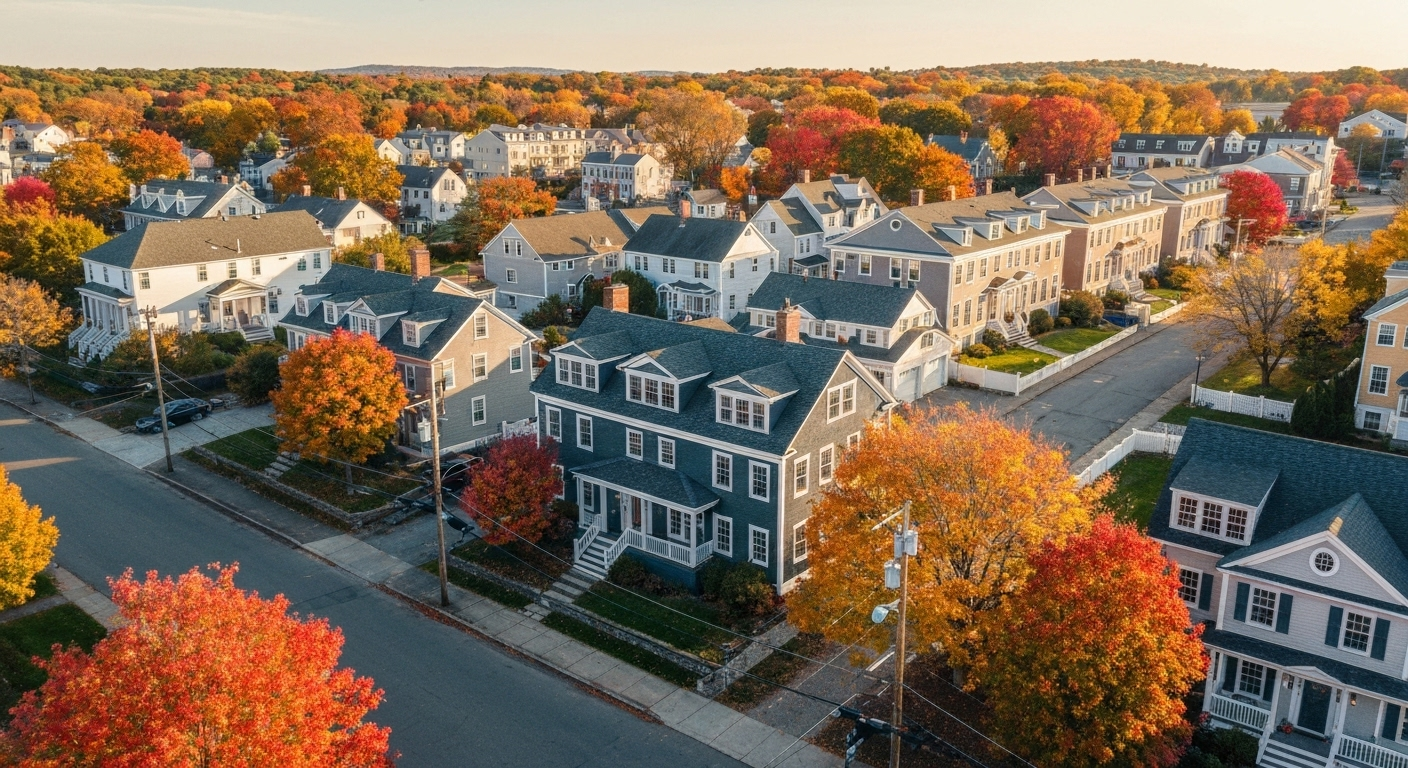Key Highlights
- The New England real estate market is mixed, with some areas favoring sellers while others are shifting to a buyer’s market.
- Home prices are stabilizing, and price growth is slowing in many parts of New England, though certain cities remain competitive.
- Inventory is on the rise in some suburban and rural areas, giving homebuyers more options and negotiation power.
- Stable interest rates and a resilient economy continue to support the housing market across the region.
- Population growth, driven by remote workers and younger buyers, is creating high demand in specific neighborhoods.
Introduction
Are you thinking about buying or selling a home in New England? The real estate market in this historic region is always evolving, shaped by unique local economies and changing home values. In 2025, we're seeing a fascinating mix of trends, from bustling city centers to quiet suburban towns. Understanding these shifts is the first step toward making a smart real estate decision. This guide will walk you through the current state of the New England housing market, helping you navigate your next move with confidence.
Overview of the New England Real Estate Market in 2025

The New England real estate landscape in 2025 is a tale of variation. While some areas remain expensive and competitive due to strong job markets and high demand, others are beginning to offer more opportunities for buyers. Market trends differ significantly from state to state and even from town to town.
Factors like slightly lower mortgage rates, influenced by the Federal Reserve, are helping to keep the market active. However, high demand in popular urban and suburban areas continues to put pressure on prices. This makes it crucial to understand the specific dynamics of the neighborhood you're interested in. Now, let’s look at the economic drivers shaping these conditions and why the region is attracting so many new residents.
Key Economic Drivers Shaping Current Housing Trends
Several key economic factors are influencing the current market dynamics in New England. Job growth in diverse sectors has boosted buyer confidence, making people more willing to invest in a new home. This economic resilience, combined with a rich cultural heritage, helps stabilize the housing market and supports long-term property values.
Additionally, interest rates play a significant role. While rates are higher than their historic lows, the Federal Reserve's recent actions to stabilize the economy have kept them from climbing uncontrollably. This stability makes financing a home more predictable for buyers, even as market trends fluctuate.
Ultimately, the combination of a strong job market, demographic shifts, and steady consumer confidence makes the New England housing market both competitive and expensive. Limited housing supply in high-demand areas further fuels this environment, creating a challenging but rewarding market for buyers and sellers.
Why New England Is Attracting More Homebuyers Than Ever
New England has seen a surge in population growth, with more homebuyers flocking to the region than ever before. A major reason for this is the rise of remote work. The flexibility to work from anywhere has allowed many to leave high-cost cities in search of a better quality of life, and New England offers just that.
This high demand is also fueled by demographic shifts, including a wave of millennial homebuyers entering the market. They are often drawn to the region's unique blend of vibrant cities and peaceful natural landscapes. Working with a knowledgeable real estate agent can help you find the perfect spot that fits your lifestyle.
What makes New England so appealing?
- Quality of Life: Access to beautiful scenery, from mountains to coastlines.
- Strong Job Markets: Diverse industries and robust educational institutions.
- Charming Communities: A mix of historic towns and modern suburbs.
- Four-Season Recreation: Opportunities for outdoor activities all year round.
Comparative Housing Market Strength Across New England States
The housing market strength varies significantly across the New England states. While some states boast highly competitive markets with soaring home prices, others offer more balanced market conditions. For example, Massachusetts, particularly around Boston, remains one of the strongest and most competitive seller's markets due to high demand and limited space.
In contrast, states like Maine and New Hampshire are seeing an increase in housing inventory in their suburban and rural areas, creating more opportunities for buyers. Let's compare some of these states to see where you might find the best fit for your real estate goals.
Massachusetts vs Connecticut: Home Price and Demand Analysis
When comparing Massachusetts and Connecticut, you’ll find two distinct real estate environments. Massachusetts, especially in the Greater Boston area, continues to experience high demand and tight inventory, which keeps home prices elevated. Boston remains a strong seller’s market.
Connecticut, on the other hand, shows a different kind of strength. Cities like Hartford are seeing robust price appreciation, with a forecasted growth of over 5%. This indicates a growing demand but perhaps from a more affordable starting point compared to the hotspots in Massachusetts.
Rhode Island, Maine, New Hampshire, and Vermont: Market Highlights
Beyond the competitive markets of Massachusetts, the rest of New England offers a diverse real estate market with pockets of excellent value. States like Maine and New Hampshire are seeing more homes come on the market, particularly in suburban and rural areas, which helps ease competition.
While urban centers like Manchester and Nashua in New Hampshire remain competitive, smaller towns across the region are becoming more buyer-friendly. The real estate market in Vermont and Rhode Island also features emerging neighborhoods where buyers can find more affordable options and potential for future growth.
Here are a few highlights:
- Maine: Increased inventory in suburban areas gives buyers more negotiating power.
- New Hampshire: Smaller towns are emerging as balanced markets with more affordable homes.
- Vermont & Rhode Island: Offer a mix of affordability and growth potential outside the main hotspots.
House Prices and Inventory Trends in Major New England Cities

Across major New England metros, we're seeing a gradual shift in home values and inventory levels. While inventory is still low from a historical perspective, the number of listings is the highest it's been since early 2020. This increase in available homes is starting to slow down the rapid price growth we saw in previous years.
This trend toward stabilization means that while some metro areas are still hot, others are cooling off. This provides a more balanced environment for both buyers and sellers. Let’s examine how pricing and inventory are changing in specific cities.
Boston, Hartford, Providence: Price Changes and Inventory Shifts
The market trends in New England's major cities show significant variation. Boston continues to be defined by high demand and tight inventory. While price changes have slowed from their peak, the city center remains one of the most competitive markets in the region.
In contrast, Hartford is experiencing strong upward momentum, with home prices projected to appreciate by over 5% year-over-year. This suggests a growing interest in the city as buyers seek more affordable urban options. This shift highlights a broader trend of buyers looking for value outside of the most expensive metros.
Providence finds itself in a middle ground. It benefits from its proximity to Boston but maintains a more accessible price point. The market here is active, but inventory shifts are creating new opportunities for buyers who may be priced out of more competitive areas.
Smaller Cities and Suburbs: Emerging Opportunities for Buyers
For buyers seeking value, the real opportunity in New England may lie in its smaller cities and suburbs. As major metro areas remain competitive, these emerging markets are becoming increasingly attractive. The market dynamics here are often more balanced, with more inventory and less aggressive competition.
This is especially true in Northern New England, where the 2025 outlook is positive for buyers. Areas in Maine, New Hampshire, and Vermont are seeing an influx of listings, providing more choices. A local real estate agent can help you identify these hidden gems.
Consider exploring these areas for better value:
- Suburban Maine: Quieter neighborhoods with more space and less competition.
- Smaller New Hampshire towns: More affordable options with potential for future growth.
- Outer suburbs of major cities: A mix of affordability and accessibility.
Buyer’s Market vs Seller’s Market: What’s Happening in New England?
So, is it a buyer’s market or a seller’s market in New England? The answer is: it’s complicated. The region is not a monolith; it's a mix of both. While major urban centers like Boston still heavily favor sellers, many suburban and rural areas are shifting toward a buyer’s market.
This change in market dynamics means buyers have more room for negotiation in certain locations, while sellers in others still hold the upper hand. Understanding these nuances is key to success. Let's look at how this plays out in bidding wars and the search for off-market properties.
Market Dynamics in 2025: Bidding Wars and Negotiation Power
One of the clearest signs of a market shift is the decline in bidding wars. In areas with more inventory, the fierce competition of the past few years has cooled. This gives buyers more negotiation power and time to make thoughtful decisions without the pressure of competing offers.
Attending open houses can give you a feel for the level of competition in a specific neighborhood. If you notice homes are staying on the market longer and sellers are more willing to adjust their prices, you likely have more leverage. Your real estate agent can help you craft an offer that reflects these current conditions.
In this market, buyers can expect:
- Fewer bidding wars in many suburbs and smaller towns.
- More room to negotiate on price, contingencies, and closing costs.
- More manageable monthly payments as prices stabilize.
Off-Market Properties and Where Buyers Find Value
In a competitive market, finding value often means looking beyond public listings. Off-market properties, also known as pocket listings, can be a great source of opportunity for savvy buyers. These are homes that are for sale but not advertised on the open market.
To access these properties, you’ll need to work with well-connected real estate professionals. A good real estate brokerage often has a network of contacts and knowledge of homeowners who may be considering selling. This inside track can help you avoid bidding wars and find a home that fits your needs and budget.
When searching for off-market properties, buyers can expect:
- Less competition than with publicly listed homes.
- The need for a strong relationship with a local agent.
- Opportunities to find unique homes that aren't widely available.
Regional Value and Affordability: Where to Get More for Your Money
For many homebuyers, especially first-time buyers, affordability is a top priority. While parts of New England are expensive, there are still regions that offer excellent value. The key is to look beyond the traditional hotspots and explore emerging neighborhoods and smaller towns where market conditions are more favorable.
These areas often provide more for your money, whether it's a larger home, more land, or simply a lower price tag. The following section will highlight some of the fastest-growing areas that are perfect for those looking to maximize their investment.
Fastest-Growing Areas and Neighborhoods for First-Time Buyers
First-time buyers looking for value should turn their attention to the fastest-growing areas in New England. These neighborhoods often offer a combination of affordability, quality of life, and potential for long-term appreciation. Many are located in the suburbs or smaller cities that are gaining popularity.
For instance, certain towns in New Hampshire and suburban areas in Maine are becoming top picks for those entering the housing market. These locations provide a welcome alternative to the high prices of major urban centers, without sacrificing access to amenities and community.
Here are some top picks for first-time buyers:
- Emerging suburbs around Hartford, CT: Benefit from the city’s growth at a lower cost.
- Smaller towns in New Hampshire: Offer affordability and a balanced market.
- Rural and suburban communities in Maine: Provide more space and negotiation power.
Conclusion
In summary, the New England real estate market is experiencing dynamic shifts driven by various economic factors and changing buyer preferences. As we look towards 2025, homebuyers are increasingly drawn to the region due to its unique blend of opportunity, affordability, and quality of life. Whether you’re eyeing bustling cities or charming suburbs, understanding these trends will equip you with the insights needed to make informed decisions. If you’re ready to explore your options in this vibrant market, don’t hesitate to reach out for a free consultation. Your ideal home in New England could be just around the corner!





